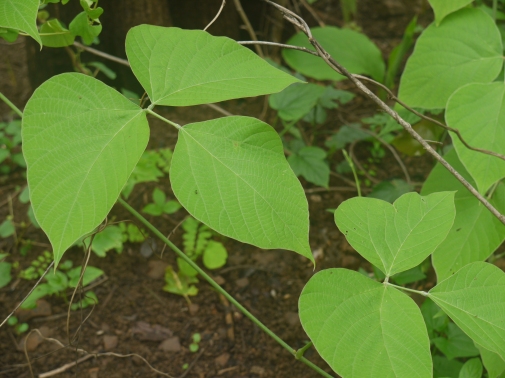
(Pueraria montana)
What is it?
Kudzu is a perennial woody vine native to Asia. It has trifoliate leaves composed of three leaflets. Each leaflet is large and ovate with two to three lobes each and hair on the underside. Along the vines are nodes, points at which stems or tendrils can propagate to increase support and attach to structures. As a twining vine, kudzu uses stems or tendrils that can extend from any node on the vine to attach to and climb most surfaces. In addition, the nodes of the kudzu vine have the ability to root when exposed to soil, further anchoring the vine to the ground. The roots are tuberous and are high in starch and water content, and the twining of the plant allows for less carbon concentration in the construction of woody stems and greater concentration in roots, which aids root growth. The roots can account for up to 40% of total plant biomass.
Where does it live?
Kudzu is believed to have originated in Japan, where the ecosystem (primarily the tendency of kudzu to experience above-ground die back over winter) kept the vine from becoming a nuisance. Although kudzu prefers forest regrowth and edge habitats with high sun exposure, the plant can survive in full sun or partial shade.These attributes of kudzu made it attractive as an ornamental plant for shading porches in the southeastern United States, but they facilitated the growth of kudzu as it became a “structural parasite” of the South, enveloping entire structures when untreated and often referred to as “the vine that ate the South”.
Why is it here?
Kudzu is one of the most aggressive and destructive invasive species ever introduced to the Americas. It has destroyed, and continues to destroy, massive swaths of native forests, particularly in the southern United States. As with with the woody vines of Puerto Rico, Kudzu’s zone of growth is expanding, and it is pushing out larger, older trees as it expands. As the climate warms Kudzu creeps further north with each passing year. Currently the northern edge of its zone is, essentially, New York City, or a little further north.
Of Note:
In China, kudzu root is used in herbal remedies, teas, and the treatment of alcohol-related problems. The efficacy of the treatment of alcohol-related problems is currently under question, but experiments show promising results. In Japan, the root starch extracted from kudzu roots is used in cooking and natural medicines, and it is used to make hay that sick animals will eat. The starch is used in Japanese cuisine, and is widely consumed as such in that country. Kudzu is also used as a food crop in Java, Sumatra, and Malaya, and can be found in Puerto Rico and South America. Other uses may include: paper products, food products, insect repellents (the smoke from burning leaves), honey, and methane production. Kudzu also has potential as a source for biofuel.